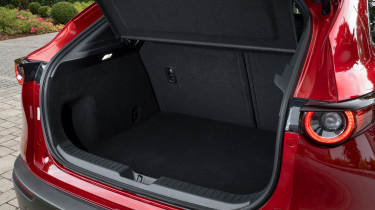We aren’t fans of the glossy black trim that surrounds the gearlever and infotainment control wheel, these are frequent touchpoints so it’s likely to get scratched easily. Overall, the quality of the plastics and soft leathers used inside is great.
Infotainment, sat-nav and stereo
One particular highlight of the cabin is the control wheel that can be used to operate the CX-30’s touchscreen. You can use either the wheel or the screen, but we found the display to be a bit of a reach away (especially if you’re tall and have your seat set back), so it makes more sense to grab the control wheel thanks to its position on the centre console next to the gearlever.
Once you’re familiar with its functions, it’s a breeze to use when you’re on the move, while the separate climate and audio controls on the dashboard are logically laid out. All versions of the CX-30 feature a head-up display, so you don’t even need to take your eyes off the road to check your speed.
The CX-30’s display measures 10.25 inches across, but it has more of a letterbox layout than most rival systems. It’s set high on the dash, which makes it hard to reach, so the control wheel should be the default choice when it comes to controlling the screen.
Expert view, on design
“Some tasks, such as inputting addresses, are tricky to do with the click wheel, but overall the system is logical and easy to understand. Turning the dial to select functions soon becomes second nature. The shortcut buttons around the wheel are useful, too.” – Dean Gibson, senior test editor. Tested the Mazda CX-30 2.5 against a Suzuki Vitara.
CX-30’s size and shape means it offers a bit more room than the 3 hatch on which it’s based

| Pros | Cons |
|
|
It’s more of a crossover than an SUV, so the CX-30 only offers slightly more space than the Mazda 3 hatch that uses the same platform.
Dimensions and size
The proportions of the CX-30, with its long bonnet and curved rear end, mean it looks more like a high-riding hatchback than an SUV. It has the usual black cladding to help with its off-road appeal, though, and the space on offer inside is on a par with rival models such as the Volkswagen T-Roc.
|
Dimensions |
|
| Length | 4,395mm |
| Width | 1,795mm |
| Height | 1,540mm |
| Number of seats | Five |
| Boot space | 422-1,398 litres |
Driving position, seats & space in the front
A sporty driving position is available, because the seat adjusts quite low. It can be set higher, of course, while a wide range of steering wheel adjustment is on offer, too. Higher-spec Takumi cars (and the £1,500 Luxury Pack for Exclusive-Line models) feature a memory driver’s seat.


